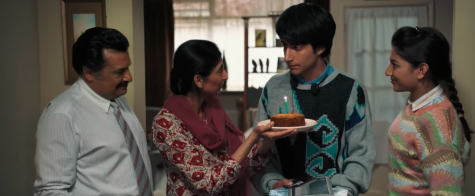“Blinded by the Light” lights the way for South Asian characters to come
October 14, 2019
Apu Nahasapeemapetilon from “The Simpsons,” Raj Koothrappali from “The Big Bang Theory,” Kelly Kapoor from “The Office.”
The ranks of South Asian characters in Hollywood are limited, but the release of South Asian-led “Blinded by the Light” has added to them.

Javed celebrates his birthday with his parents and sister, complete with a homemade cake and his ever-present headphones and cassette of Bruce Springsteen.
This August, Indian director Gurinder Chadha released “Blinded by the Light,” a dramatic comedy about a Bruce Springsteen-obsessed Pakistani teenager named Javed Khan (Viveik Kalra). Set in England during the 80s, the story follows Javed on his path to becoming a writer, despite his parents’ resistance and lack of support. On the surface, this may seem like any other movie catering to 80s nostalgia, but it actually goes above and beyond in providing a well-rounded and realistic representation of the South Asian family.
Part of the appeal of this movie is the South Asian family at the center of the story. These characters and family dynamics aren’t seen often in American movies, even though these dynamics are the reality for the many South Asian people watching. “Blinded by the Light” is an important step in bridging what is seen in pop culture with the much more diverse set of realities people have.
The South Asian characters in “Blinded by the Light” are made even more special because of their depth and authenticity. Too often, these characters are caricatures of the culture, stereotyped as socially awkward, overly academic (usually STEM subjects) and “model minorities” with an entrepreneurial spirit and strict parents. These characters also almost never get the same amount of character development as their white counterparts and have no real motivations for their actions besides what are perceived to be traditional South Asian values. In contrast, “Blinded by the Light” breaks that trend by creating South Asian characters of substance. While Javed is a typical rebellious teenager, his character also feels a deep sense of family loyalty, and going against his father isn’t an easy or liberating task. Javed’s father doesn’t want him to pursue journalism, but it’s not because he doesn’t want his son to be happy. Rather, he knows what it is like to be poor and doesn’t want Javed to have to worry about money like he did. These details, insights and explanation of motivations make for nuanced, more developed characters who break away from the very one-dimensional mold of most South Asian characters in Hollywood.
The characters in “Blinded by the Light” are actually relatable, not just contrived characters stuck into a movie to score some diversity points. These characters only serve to reinforce the idea that having South Asian characters is outside of what is considered the norm. The dissonant manner in which most South Asian characters are shoved into pop culture gives the impression that these characters can’t be incorporated into a movie in a natural way. In contrast, the well-rounded characters in “Blinded by the Light” send the message that having South Asians lead a movie is normal, rather than something that ought to be viewed as a special, one-time-only thing.
Ultimately, “Blinded by the Light” is a good movie, but more than that, it is an important movie. Coming on the heels of other movies recognized for their meaningful representation like “Crazy Rich Asians,” this movie contributes to the long process of normalizing South Asian—or simply non-white—main characters. Even if you aren’t South Asian or a fan of Bruce Springsteen, this movie is a milestone in representation and indubitably worth seeing.




